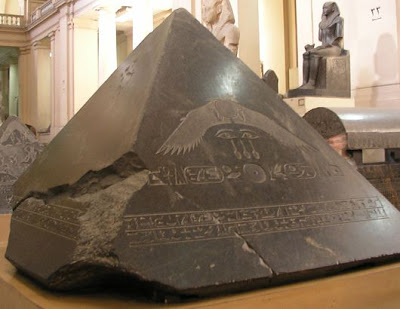History
The Egyptian Museum owes its existence to the Egyptian Antiquities Service, established by the Egyptian government in 1835 to limit the looting of Egypt's priceless artifacts.
The museum opened in 1858 with a collection assembled by Auguste Mariette, the French archaeologist retained by Isma'il Pasha. It was originally housed in an annex of the palace of Ismail Pasha in Giza, the museum moved to its present location in 1900.
The Egyptian Museum's collection includes over 120,000 items. As at the Louvre Museum in Paris, it is necessary to be selective during a visit.
One major highlight is the famous Pharaoh Tutankhamen tomb collection on the museum's upper floor. The tomb of "King Tut" (as he is better known) was found remarkably intact by Howard Carter in the Valley of the Kings in 1923. Artifacts on display include the gold funerary mask and sarcophagus, four huge gilded boxes that fit inside each other, an ancient trumpet, thrones, and even a royal toilet seat.
Also upstairs is the royal Mummy Room, which houses 11 royal mummies from pharaonic times. It has a significant entrance fee and does not allow photos, but the adjacent (free) room has a nice assortment of mummified animals and birds.




Pharaoh statue outside the Egyptian Museum

King Tutankhamun Chair

The last stone on the top of a pyramid was a mini-pyramid in granite, often covered with gold or electrum (an alloy of gold and silver). In the museum you will find several pyramideons in the first large hall straight ahead when entering the museum.

Facade of a private temple at Amarna, now in the Egyptian Museum


The "treasures" of Tutankhamun have been marvelled at since their discovery by Howard Carter in 1922. It took a decade to catalogue, remove and conserve the thousands of items in the small tomb. A few of the items are displayed here and on following pages to be added as time permits. The two innermost sarcophagi are displayed in the Cairo Museum, while the outer most one still holds the mummy of Tutankhamun and resides in his tomb in the Valley of the Kings.


Tutankhamun's second sarcophagus. Differences in
its facial features suggest that it was probably
intended for someone else.
Tutankhamun's third, innermost sarcophagus.
Beaten from heavy gold sheet,
it weighs 110.4 kg.
م
The Egyptian Museum owes its existence to the Egyptian Antiquities Service, established by the Egyptian government in 1835 to limit the looting of Egypt's priceless artifacts.
The museum opened in 1858 with a collection assembled by Auguste Mariette, the French archaeologist retained by Isma'il Pasha. It was originally housed in an annex of the palace of Ismail Pasha in Giza, the museum moved to its present location in 1900.
The Egyptian Museum's collection includes over 120,000 items. As at the Louvre Museum in Paris, it is necessary to be selective during a visit.
One major highlight is the famous Pharaoh Tutankhamen tomb collection on the museum's upper floor. The tomb of "King Tut" (as he is better known) was found remarkably intact by Howard Carter in the Valley of the Kings in 1923. Artifacts on display include the gold funerary mask and sarcophagus, four huge gilded boxes that fit inside each other, an ancient trumpet, thrones, and even a royal toilet seat.
Also upstairs is the royal Mummy Room, which houses 11 royal mummies from pharaonic times. It has a significant entrance fee and does not allow photos, but the adjacent (free) room has a nice assortment of mummified animals and birds.




Pharaoh statue outside the Egyptian Museum

King Tutankhamun Chair

The last stone on the top of a pyramid was a mini-pyramid in granite, often covered with gold or electrum (an alloy of gold and silver). In the museum you will find several pyramideons in the first large hall straight ahead when entering the museum.

Facade of a private temple at Amarna, now in the Egyptian Museum
Tutankhamen


The "treasures" of Tutankhamun have been marvelled at since their discovery by Howard Carter in 1922. It took a decade to catalogue, remove and conserve the thousands of items in the small tomb. A few of the items are displayed here and on following pages to be added as time permits. The two innermost sarcophagi are displayed in the Cairo Museum, while the outer most one still holds the mummy of Tutankhamun and resides in his tomb in the Valley of the Kings.


Tutankhamun's second sarcophagus. Differences in
its facial features suggest that it was probably
intended for someone else.
Tutankhamun's third, innermost sarcophagus.
Beaten from heavy gold sheet,
it weighs 110.4 kg.
م




